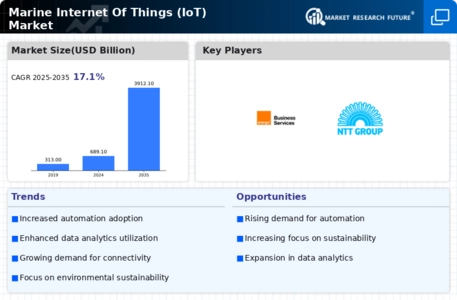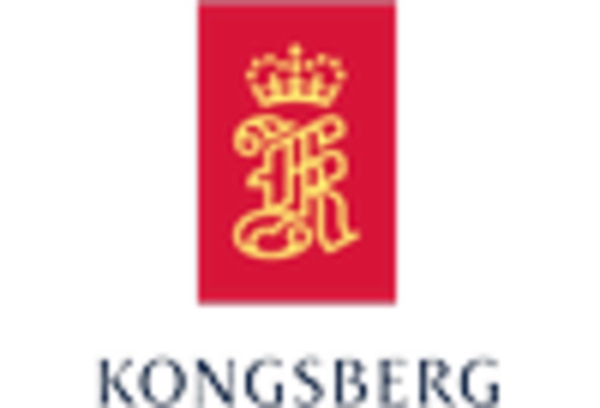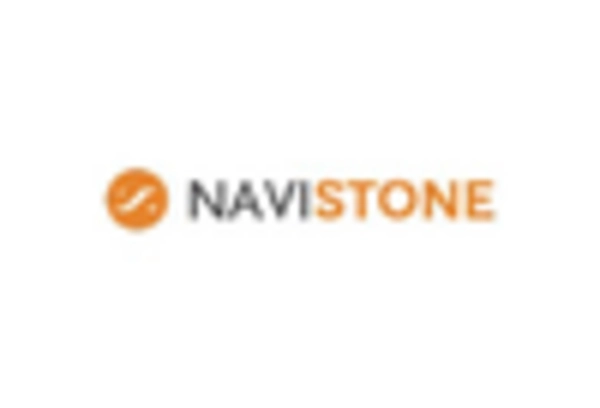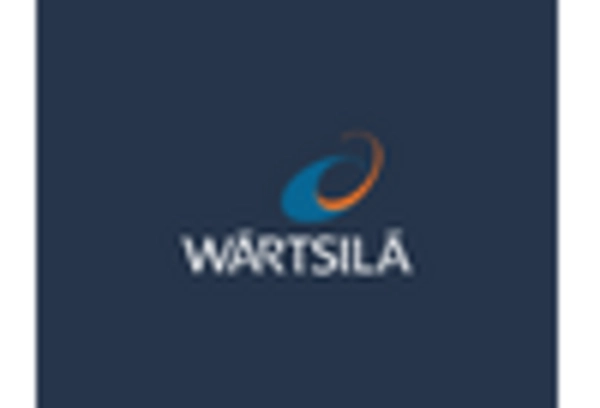-
Executive Summary
-
Market Attractiveness Analysis
- Global Marine Internet of ThingsMarket, byComponent
- Global Marine Internet of Things Market, byApplication
- Global Marine Internet of Things Market, byShip Type
- Global Marine Internet of Things Market, byRegion
-
Market Introduction
-
Market Definition
-
Scope of the Study
-
Market Structure
-
Key Buying Criteria
-
Market Factor Indicator Analysis
-
Research Methodology
-
Research Process
-
Primary Research
-
Secondary Research
-
Market Size Estimation
-
Forecast Model
-
List of Assumptions
-
Market Insights
-
Market Dynamics
-
Introduction
-
Drivers
- Increase in Seaborne Trade Globally
- Growing Maritime Tourism Industry
- Increasing Defense Expenditure
- Drivers Impact Analysis
-
Restraint
- Vulnerable to Cyberattacks
- High Initial Investment
-
Opportunities
- Use of Renewable Sources of Energy
- Advancements in Hybrid Propulsion Technology
-
Market/Technological Trends
-
Patent Trends
-
Regulatory Landscape/Standards
-
Market Factor Analysis
-
Value Chain/Supply Chain Analysis
- R&D
- Manufacturing
- Distribution & Sales
- Post-Sales Monitoring
-
Porter’s Five Forces Analysis
- Threat of New Entrants
- Bargaining Power of Buyers
- Threat of Substitutes
- Segment Rivalry
- Bargaining Power of Supplies
-
Global Marine Internet of Things Market, by Component
-
Introduction
-
Sensing Devices
-
Network Connectivity
-
IoT Platforms
-
IT Solutions & Services
-
Global Marine Internet of Things Market, by Application
-
Introduction
-
Route & Operation Optimization
-
Asset Tracking
-
Equipment Monitoring
-
Global Marine Internet of Things Market, by Ship Type
-
Introduction
-
Commercial
- Cargo Vessels
- Passenger Vessels
- Others
-
Defense
- Destroyers
- Destroyers
- Frigates
- Corvettes
- Offshore Support Vessels (OSV)
- Aircraft Carriers
- Submarines
-
Global Marine Internet of Things Market, by Region
-
Introduction
-
North America
- US
- Canada
-
Europe
- UK
- Germany
- France
- Italy
- Rest of Europe
-
Asia-Pacific
- China
- Japan
- India
- Australia
- Rest of Asia-Pacific
-
Middle East & Africa
- Saudi Arabia
- UAE
- Rest of Middle East & Africa
-
Latin America
- Brazil
- Rest of Latin America
-
Competitive Landscape
-
Competitive Overview
-
Competitor Dashboard
-
Major Growth Key Strategies in the Global Marine Internet of Things Market
-
Competitive Benchmarking
-
Market Share Analysis
-
Leading Player in terms of the Number of Developments in the Global Marine Internet of Things Market
-
Key Developments & Growth Strategies
- New Product/Service ApplicationLaunch
- Merger & Acquisition
- Joint Ventures
-
Company Profiles
-
Key Market Players
- Cisco Systems, Inc.
- Marine Digital GmbH
- Vodafone Group Plc
- Ericsson AB
- Orange Business Services
- Wartsila OyjAbp
- Accenture Plc
- Dualog AS
- Wilhelmsen Holding ASA
- NTT Group
-
(Company overview, financial updates, products & service offered, key developments, SWOT analysis, and key strategies to be provided for all the listed companies)
-
Appendix
-
References
-
Related Reports
-
List of Abbreviation
-
List of Tables
-
LIST OF ASSUMPTIONS
-
MAJOR PATENTS GRANTED FOR MARINE INTERNET OF THINGS (2015–2020)
-
COMPONENT: GLOBAL MARINE INTERNET OF THINGS MARKET, 2020–2030 (USD MILLION)
-
APPLICATION: GLOBAL MARINE INTERNET OF THINGS MARKET, 2020–2030 (USD MILLION)
-
SHIP TYPE: GLOBAL MARINE INTERNET OF THINGS MARKET, 2020–2030(USD MILLION)
-
GLOBAL MARINE INTERNET OF THINGS MARKET, BY REGION, 2020–2030 (USD MILLION)
-
NORTH AMERICA: MARINE INTERNET OF THINGS MARKET, BY COUNTRY, 2020–2030(USD MILLION)
-
NORTH AMERICA: MARINE INTERNET OF THINGS MARKET, BY COMPONENT, 2020–2030 (USD MILLION)
-
NORTH AMERICA: MARINE INTERNET OF THINGS MARKET, BY APPLICATION, 2020–2030 (USD MILLION)
-
NORTH AMERICA: MARINE INTERNET OF THINGS MARKET, BY SHIP TYPE, 2020–2030 (USD MILLION)
-
US: MARINE INTERNET OF THINGS MARKET, BY COMPONENT, 2020–2030 (USD MILLION)
-
US: MARINE INTERNET OF THINGS MARKET, BY APPLICATION, 2020–2030 (USD MILLION)
-
US: MARINE INTERNET OF THINGS MARKET, BY SHIP TYPE, 2020–2030 (USD MILLION)
-
CANADA: MARINE INTERNET OF THINGS MARKET, BY COMPONENT, 2020–2030 (USD MILLION)
-
CANADA: MARINE INTERNET OF THINGS MARKET, BY APPLICATION, 2020–2030 (USD MILLION)
-
CANADA: MARINE INTERNET OF THINGS MARKET, BY SHIP TYPE, 2020–2030 (USD MILLION)
-
EUROPE: MARINE INTERNET OF THINGS MARKET, BY COUNTRY, 2020–2030 (USD MILLION)
-
EUROPE: MARINE INTERNET OF THINGS MARKET, BY COMPONENT, 2020–2030 (USD MILLION)
-
EUROPE: MARINE INTERNET OF THINGS MARKET, BY APPLICATION, 2020–2030 (USD MILLION)
-
EUROPE: MARINE INTERNET OF THINGS MARKET, BY SHIP TYPE, 2020–2030 (USD MILLION)
-
UK: MARINE INTERNET OF THINGS MARKET, BY COMPONENT, 2020–2030 (USD MILLION)
-
UK: MARINE INTERNET OF THINGS MARKET, BY APPLICATION, 2020–2030 (USD MILLION)
-
UK: MARINE INTERNET OF THINGS MARKET, BY SHIP TYPE, 2020–2030 (USD MILLION)
-
GERMANY: MARINE INTERNET OF THINGS MARKET, BY COMPONENT, 2020–2030 (USD MILLION)
-
GERMANY: MARINE INTERNET OF THINGS MARKET, BY APPLICATION, 2020–2030 (USD MILLION)
-
GERMANY: MARINE INTERNET OF THINGS MARKET, BY SHIP TYPE, 2020–2030 (USD MILLION)
-
FRANCE: MARINE INTERNET OF THINGS MARKET, BY COMPONENT, 2020–2030 (USD MILLION)
-
FRANCE: MARINE INTERNET OF THINGS MARKET, BY APPLICATION, 2020–2030 (USD MILLION)
-
FRANCE: MARINE INTERNET OF THINGS MARKET, BY SHIP TYPE, 2020–2030 (USD MILLION)
-
ITALY: MARINE INTERNET OF THINGS MARKET, BY COMPONENT, 2020–2030 (USD MILLION)
-
ITALY: MARINE INTERNET OF THINGS MARKET, BY APPLICATION, 2020–2030 (USD MILLION)
-
ITALY: MARINE INTERNET OF THINGS MARKET, BY SHIP TYPE, 2020–2030 (USD MILLION)
-
REST OF EUROPE: MARINE INTERNET OF THINGS MARKET, BY COMPONENT, 2020–2030 (USD MILLION)
-
REST OF EUROPE: MARINE INTERNET OF THINGS MARKET, BY APPLICATION, 2020–2030 (USD MILLION)
-
REST OF EUROPE: MARINE INTERNET OF THINGS MARKET, BY SHIP TYPE, 2020–2030 (USD MILLION)
-
ASIA-PACIFIC: MARINE INTERNET OF THINGS MARKET, BY COUNTRY, 2020–2030 (USD MILLION)
-
ASIA-PACIFIC: MARINE INTERNET OF THINGS MARKET, BY COMPONENT, 2020–2030 (USD MILLION)
-
ASIA-PACIFIC: MARINE INTERNET OF THINGS MARKET, BY APPLICATION, 2020–2030 (USD MILLION)
-
ASIA-PACIFIC: MARINE INTERNET OF THINGS MARKET, BY SHIP TYPE, 2020–2030 (USD MILLION)
-
CHINA: MARINE INTERNET OF THINGS MARKET, BY COMPONENT, 2020–2030 (USD MILLION)
-
CHINA: MARINE INTERNET OF THINGS MARKET, BY APPLICATION, 2020–2030 (USD MILLION)
-
CHINA: MARINE INTERNET OF THINGS MARKET, BY SHIP TYPE, 2020–2030 (USD MILLION)
-
INDIA: MARINE INTERNET OF THINGS MARKET, BY COMPONENT, 2020–2030 (USD MILLION)
-
INDIA: MARINE INTERNET OF THINGS MARKET, BY APPLICATION, 2020–2030 (USD MILLION)
-
INDIA: MARINE INTERNET OF THINGS MARKET, BY SHIP TYPE, 2020–2030 (USD MILLION)
-
JAPAN: MARINE INTERNET OF THINGS MARKET, BY COMPONENT, 2020–2030(USD MILLION)
-
JAPAN: MARINE INTERNET OF THINGS MARKET, BY APPLICATION, 2020–2030 (USD MILLION)
-
JAPAN: MARINE INTERNET OF THINGS MARKET, BY SHIP TYPE, 2020–2030 (USD MILLION)
-
AUSTRALIA: MARINE INTERNET OF THINGS MARKET, BY COMPONENT, 2020–2030 (USD MILLION)
-
AUSTRALIA: MARINE INTERNET OF THINGS MARKET, BY APPLICATION, 2020–2030 (USD MILLION)
-
AUSTRALIA: MARINE INTERNET OF THINGS MARKET, BY SHIP TYPE, 2020–2030 (USD MILLION)
-
REST OF ASIA-PACIFIC: MARINE INTERNET OF THINGS MARKET, BY COMPONENT, 2020–2030 (USD MILLION)
-
REST OF ASIA-PACIFIC: MARINE INTERNET OF THINGS MARKET, BY APPLICATION, 2020–2030 (USD MILLION)
-
REST OF ASIA-PACIFIC: MARINE INTERNET OF THINGS MARKET, BY SHIP TYPE, 2020–2030 (USD MILLION)
-
MIDDLE EAST & AFRICA: MARINE INTERNET OF THINGS MARKET, BY COUNTRY, 2020–2030 (USD MILLION)
-
MIDDLE EAST & AFRICA: MARINE INTERNET OF THINGS MARKET, BY COMPONENT, 2020–2030 (USD MILLION)
-
MIDDLE EAST & AFRICA: MARINE INTERNET OF THINGS MARKET, BY APPLICATION, 2020–2030 (USD MILLION)
-
MIDDLE EAST & AFRICA: MARINE INTERNET OF THINGS MARKET, BY SHIP TYPE, 2020–2030 (USD MILLION)
-
SAUDI ARABIA: MARINE INTERNET OF THINGS MARKET, BY COMPONENT, 2020–2030 (USD MILLION)
-
SAUDI ARABIA: MARINE INTERNET OF THINGS MARKET, BY APPLICATION, 2020–2030 (USD MILLION)
-
SAUDI ARABIA: MARINE INTERNET OF THINGS MARKET, BY SHIP TYPE, 2020–2030 (USD MILLION)
-
UAE: MARINE INTERNET OF THINGS MARKET, BY COMPONENT, 2020–2030 (USD MILLION)
-
UAE: MARINE INTERNET OF THINGS MARKET, BY APPLICATION, 2020–2030 (USD MILLION)
-
UAE: MARINE INTERNET OF THINGS MARKET, BY SHIP TYPE, 2020–2030 (USD MILLION)
-
REST OF THE MIDDLE EAST & AFRICA: MARINE INTERNET OF THINGS MARKET, BY COMPONENT, 2020–2030 (USD MILLION)
-
REST OF THE MIDDLE EAST & AFRICA: MARINE INTERNET OF THINGS MARKET, BY APPLICATION, 2020–2030 (USD MILLION)
-
REST OF THE MIDDLE EAST & AFRICA: MARINE INTERNET OF THINGS MARKET, BY SHIP TYPE, 2020–2030 (USD MILLION)
-
LATIN AMERICA: MARINE INTERNET OF THINGS MARKET, BY COUNTRY, 2020–2030 (USD MILLION)
-
LATIN AMERICA: MARINE INTERNET OF THINGS MARKET, BY COMPONENT, 2020–2030 (USD MILLION)
-
LATIN AMERICA: MARINE INTERNET OF THINGS MARKET, BY APPLICATION, 2020–2030 (USD MILLION)
-
LATIN AMERICA: MARINE INTERNET OF THINGS MARKET, BY SHIP TYPE, 2020–2030 (USD MILLION)
-
BRAZIL: MARINE INTERNET OF THINGS MARKET, BY COMPONENT, 2020–2030 (USD MILLION)
-
BRAZIL: MARINE INTERNET OF THINGS MARKET, BY APPLICATION, 2020–2030 (USD MILLION)
-
BRAZIL: MARINE INTERNET OF THINGS MARKET, BY SHIP TYPE, 2020–2030 (USD MILLION)
-
REST OF LATIN AMERICA: MARINE INTERNET OF THINGS MARKET, BY COMPONENT, 2020–2030 (USD MILLION)
-
REST OF LATIN AMERICA: MARINE INTERNET OF THINGS MARKET, BY APPLICATION,2020–2030 (USD MILLION)
-
REST OF LATIN AMERICA: MARINE INTERNET OF THINGS MARKET, BY FREQUENCY-BAND, 2020–2030 (USD MILLION)
-
THE MOST ACTIVE PLAYERS IN THE GLOBAL MARINE INTERNET OF THINGS MARKET
-
CONTRACTS & AGREEMENTS
-
MERGERS & ACQUISITIONS
-
PRODUCT DEVELOPMENTS
-
EXPANSIONS & INVESTMENTS
-
JOINT VENTURES & PARTNERSHIPS
-
-
List of Figures
-
MARKET SYNOPSIS
-
GLOBAL MARINE INTERNET OF THINGS MARKET: MARKET ATTRACTIVENESS ANALYSIS
-
GLOBAL MARINE INTERNET OF THINGS MARKET ANALYSIS, BY COMPONENT
-
GLOBAL MARINE INTERNET OF THINGS MARKET ANALYSIS, BY APPLICATION
-
GLOBAL MARINE INTERNET OF THINGS MARKET ANALYSIS, BY SHIP TYPE
-
GLOBAL MARINE INTERNET OF THINGS MARKET ANALYSIS, BY REGION
-
GLOBAL MARINE INTERNET OF THINGS MARKET: MARKET STRUCTURE
-
KEY BUYING CRITERIA FOR MARINE COMPONENTS
-
RESEARCH PROCESS OF MRFR
-
NORTH AMERICA: MARKET SIZE & MARKET SHARE, BY COUNTRY, 2020 VS 2030
-
EUROPE: MARKET SIZE & MARKET SHARE, BY COUNTRY, 2020 VS 2030
-
ASIA-PACIFIC: MARKET SIZE & MARKET SHARE, BY COUNTRY, 2020 VS 2030
-
MIDDLE EAST & AFRICA: MARKET SIZE & MARKET SHARE, BY COUNTRY, 2020 VS 2030
-
LATIN AMERICA: MARKET SIZE & MARKET SHARE, BY REGION, 2020 VS 2030
-
MARKET DYNAMICS OVERVIEW
-
DRIVERS IMPACT ANALYSIS: GLOBAL MARINE INTERNET OF THINGS MARKET
-
CHALLENGES IMPACT ANALYSIS: GLOBAL MARINE INTERNET OF THINGS MARKET
-
PORTER’S FIVE FORCES ANALYSIS OF THE GLOBAL MARINE INTERNET OF THINGS MARKET
-
SUPPLY CHAIN: GLOBAL MARINE INTERNET OF THINGS MARKET
-
GLOBAL MARINE INTERNET OF THINGS MARKET SHARE, BY COMPONENT, 2020 (% SHARE)
-
GLOBAL MARINE INTERNET OF THINGS MARKET SHARE, BY SHIP TYPE, 2020 (% SHARE)
-
GLOBAL MARINE INTERNET OF THINGS MARKET SHARE, BY REGION, 2020 (% SHARE)
-
NORTH AMERICA: MARINE INTERNET OF THINGS MARKET SHARE, BY COUNTRY, 2020 (% SHARE)
-
EUROPE: MARINE INTERNET OF THINGS MARKET SHARE, BY COUNTRY, 2020 (% SHARE)
-
ASIA-PACIFIC: MARINE INTERNET OF THINGS MARKET SHARE, BY COUNTRY, 2020 (% SHARE)
-
MIDDLE EAST & AFRICA: MARINE INTERNET OF THINGS MARKET SHARE, BY COUNTRY, 2020 (% SHARE)
-
LATIN AMERICA: MARINE INTERNET OF THINGS MARKET SHARE, BY COUNTRY, 2020 (% SHARE)
-
COMPETITOR DASHBOARD: GLOBAL MARINE INTERNET OF THINGS MARKET
-
CAPITAL MARKET RATIO AND FINANCIAL MATRIX
-
CONTRACTS & AGREEMENTS: THE MAJOR STRATEGY ADOPTED BY KEY PLAYERS IN THE GLOBAL MARINE INTERNET OF THINGS MARKET
-
BENCHMARKING OF MAJOR COMPETITORS
-
MAJOR MANUFACTURERS MARKET SHARE ANALYSIS, 2020'

















Leave a Comment